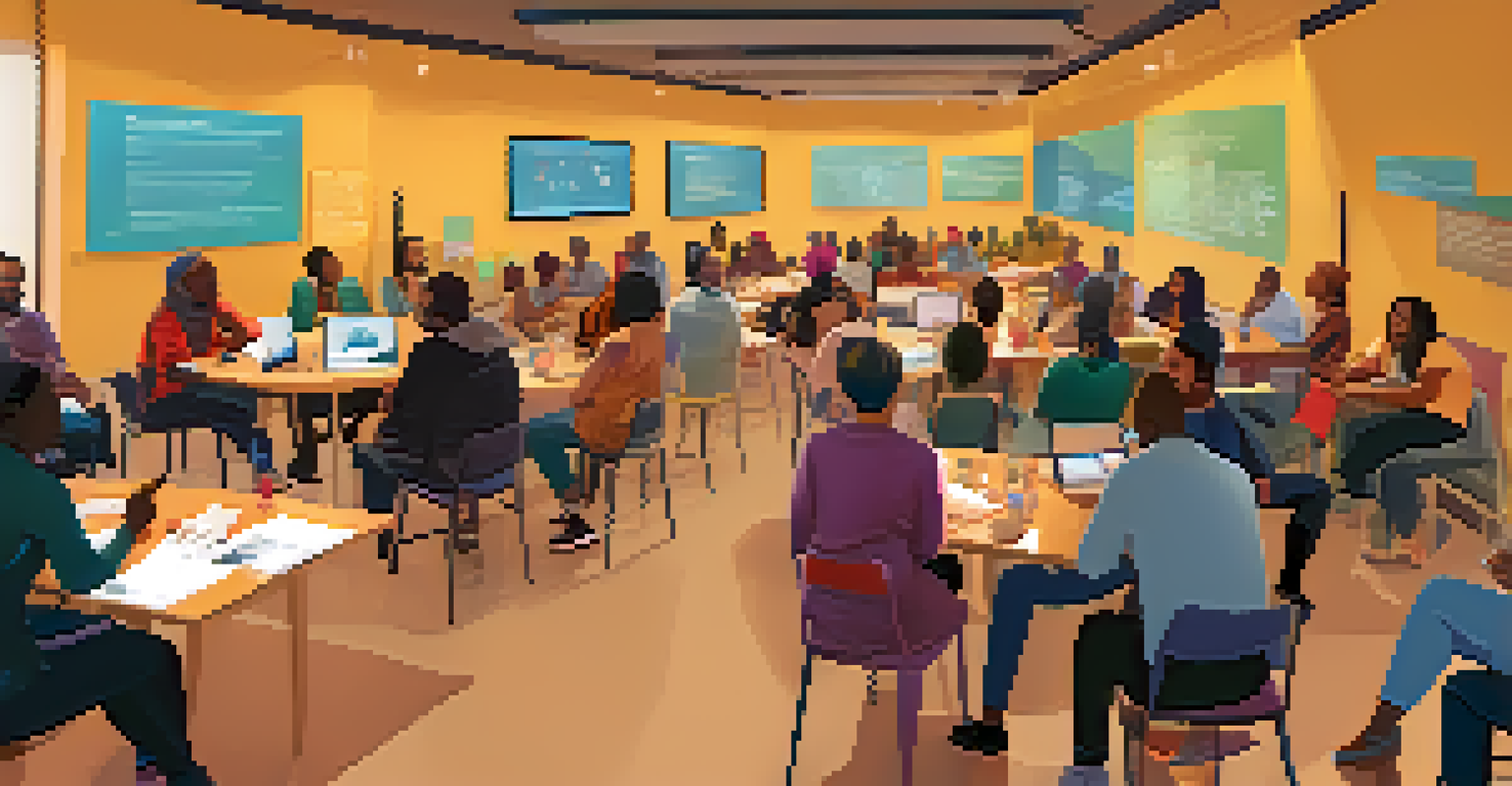Engaging with Local Communities Through Interdisciplinary Projects

Understanding Interdisciplinary Projects and Their Impact
Interdisciplinary projects bring together diverse fields, blending knowledge and skills to tackle complex community issues. Imagine a team of artists, scientists, and urban planners working together to revitalize a neighborhood park. By combining their expertise, they can create solutions that are not only innovative but also culturally relevant and sustainable.
Collaboration allows us to know more than we are capable of knowing by ourselves.
These collaborations often lead to richer outcomes, as different perspectives contribute to a more comprehensive understanding of challenges. For instance, a project aimed at improving local health might include input from healthcare professionals, nutritionists, and community members to ensure that solutions are both effective and embraced by the community.
Moreover, engaging various disciplines encourages creativity, sparking ideas that might not emerge in a more siloed approach. This synergy can inspire new community initiatives, fostering a sense of ownership and pride among residents as they see their needs being addressed in unique ways.
The Role of Community Engagement in Project Success
Community engagement is a vital component of any interdisciplinary project. When community members are actively involved, they bring invaluable insights that can shape the direction and implementation of the project. Think of it as a dance, where each partner contributes their rhythm to create a beautiful performance.

Involving local voices not only enhances the relevance of the project but also builds trust and relationships. For instance, when a local school collaborates with environmental scientists to implement a gardening program, the students and parents feel a stronger connection to the project because they were part of its design and execution.
Interdisciplinary Projects Drive Innovation
Bringing together diverse fields fosters creative solutions to complex community issues.
This engagement often leads to greater community buy-in and long-term sustainability. When residents feel invested in the process, they are more likely to support ongoing efforts and advocate for continued collaboration, creating a cycle of engagement that benefits everyone.
Examples of Successful Interdisciplinary Community Projects
One inspiring example is the 'ArtPlace America' initiative, which combines artists and community developers to revitalize neighborhoods. Through installations and performances, artists help foster community identity and pride while addressing local needs such as safety and accessibility. This approach not only beautifies spaces but also brings people together, creating a sense of belonging.
The whole is greater than the sum of its parts.
Another notable project is the collaboration between urban planners and social scientists in designing affordable housing. By understanding the social dynamics of a community, planners can create living spaces that promote interaction and inclusivity. This holistic approach helps to build not just houses, but vibrant communities where people want to live.
These examples show that when diverse disciplines come together, the possibilities for positive change are endless. They highlight the potential of interdisciplinary projects to transform not only physical spaces but also the lives of the people who inhabit them.
Building Partnerships Across Disciplines
Creating effective interdisciplinary projects starts with building strong partnerships. This involves reaching out to various stakeholders, including local organizations, businesses, and educational institutions. Think of it as assembling a puzzle; each piece represents a unique expertise that, when combined, creates a complete picture.
Establishing a common goal is crucial in these partnerships. By aligning objectives, all parties can work towards a shared vision, making collaboration smoother and more productive. For example, a project aimed at improving access to fresh food might involve local farmers, chefs, nutritionists, and community leaders, each bringing their unique perspectives to the table.
Community Engagement Ensures Success
Active involvement of community members enriches projects and builds trust and ownership.
Additionally, maintaining open communication throughout the project fosters trust and adaptability. Regular check-ins and feedback sessions can help address any challenges that arise, ensuring that the partnership remains strong and focused on delivering impactful results.
Leveraging Technology for Community Engagement
In today's digital age, technology plays a pivotal role in engaging communities. Social media platforms, for example, can be powerful tools for gathering input and feedback from residents. Imagine a local government using a platform to solicit ideas for community projects; this not only empowers citizens but also helps officials prioritize initiatives that truly matter to the community.
Moreover, technology can facilitate collaboration among interdisciplinary teams. Online project management tools allow diverse groups to share ideas, track progress, and communicate effectively, regardless of their physical location. This is particularly beneficial for projects that require expertise from various fields, as it streamlines coordination and enhances productivity.
Lastly, utilizing data analytics can provide valuable insights into community needs and preferences. By analyzing trends and feedback, project leaders can make informed decisions that resonate with the community, ultimately leading to more successful and impactful outcomes.
Challenges of Interdisciplinary Community Projects
While interdisciplinary projects offer numerous benefits, they also come with challenges. One significant hurdle is navigating differing priorities and perspectives among team members. For instance, an artist might focus on aesthetic elements, while an urban planner prioritizes functionality, which can lead to friction if not managed well.
Additionally, engaging the community can sometimes prove difficult, especially in areas with low participation rates. Overcoming barriers such as lack of awareness or skepticism about the project requires persistent outreach efforts and clear communication about the project's goals and benefits.
Technology Enhances Collaboration
Digital tools facilitate communication and engagement, making interdisciplinary work more effective.
Finally, securing funding for interdisciplinary initiatives can be tricky. Many grant programs favor traditional approaches, so project leaders may need to be creative in demonstrating the value of their collaborative efforts to potential funders. This often involves showcasing successful case studies and the unique benefits of interdisciplinary work.
The Future of Community Engagement Through Interdisciplinary Work
Looking ahead, the future of community engagement through interdisciplinary projects appears promising. As societies face increasingly complex challenges, the need for collaborative solutions will only grow. By fostering partnerships across various fields, communities can develop innovative strategies that are both effective and inclusive.
Moreover, the rise of digital platforms will continue to enhance communication and collaboration, making it easier for diverse groups to work together. This technological evolution opens doors for a broader range of participants, including marginalized voices that have historically been overlooked.

Ultimately, the success of these projects hinges on a commitment to inclusivity and adaptability. By remaining open to new ideas and perspectives, communities can not only address current issues but also build resilience for the future, ensuring that everyone has a seat at the table.